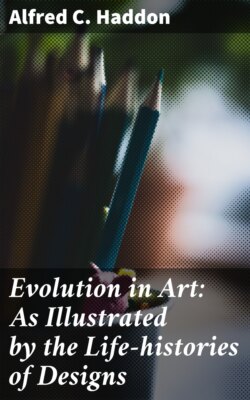Читать книгу Evolution in Art: As Illustrated by the Life-histories of Designs - Alfred C. Haddon - Страница 13
На сайте Литреса книга снята с продажи.
II. Single row of faces disposed horizontally.
Оглавление(1.) The faces looking the same way.—The belt of Fig. 11 has four faces, which are as degenerate as those in the last example; three of these look one way, and the fourth, which is at one end of the pattern, looks in the opposite direction. It is not unusual for a face to be carved at each end of the decorated portion of a belt, and as these faces almost always look towards the pattern, the anomaly of one face in this belt looking a different way from the remainder is apparent rather than real. But the most interesting feature in this belt is the meander or fret pattern. The extremely degenerate face appears to be, as in. Fig. 10, a red mouth containing an eye-spot; the central chevron also occurs in Fig. 19, where it represents the nose.
Fig. 12.—Kerrama, Berlin Museum.
(2.) The faces alternately looking towards and away from one another.—I will omit examples in which (a) all the faces are separate, and (b) the faces looking towards one another are grouped together, and pass on to (c) the faces looking away from one another are grouped together. An elegant example of this is seen in Fig. 12. The two pairs of eyes of the two faces which are turned away from each other are represented by a single eye from which a horizontal line extends on either side to the two mouths; each line represents a nose, the nostrils of which are placed quite close to the eye. The eyes are surrounded by simple red areas. The spaces between the mouths, above and below the eye (speaking in terms of the belt, and not of the faces), are occupied by additional mouths, which are evidently inserted from a sense of symmetry; that they are supplemented, and not essential, is proved by the absence of any nasal line connecting them with the eye. The spirals below each mouth occur on several shields.
Fig. 13.—British Museum.
An interesting belt (Fig. 13) exhibits quite a different modification of the same motive. The pattern consists of a series of eight-rayed figures with bent arms, and a central eye-spot. A comparison of these figures with the eyes on masks, and other objects from this district, proves that the six rays are but a symmetrical coalescence of two pairs of eye-areas.[7] The angled double lines are clearly those prolongations of the eye-area which in many cases tend to enclose the mouth, and which probably represent the cheek-folds; and thus they demonstrate the interpretation that each star is derived from two horizontal faces which are looking away from each other, and of which nothing remains but a confluent eye-area, enclosing a single eye. The terminal faces are sufficiently normal; but if two such faces were placed back to back, and the eye-areas were confluent, and the four eyes fused into one, and finally the nose and mouth were eliminated, we should have star-like figures resembling those which do occur. If a reflector is placed across the eyes in the terminal face in Fig. 13 (at right angles to the plane of the paper, and across the long axis of the belt) a star-like figure can be seen, which is very similar to those in the rest of the belt. This is one of the few belts that have no border pattern.
